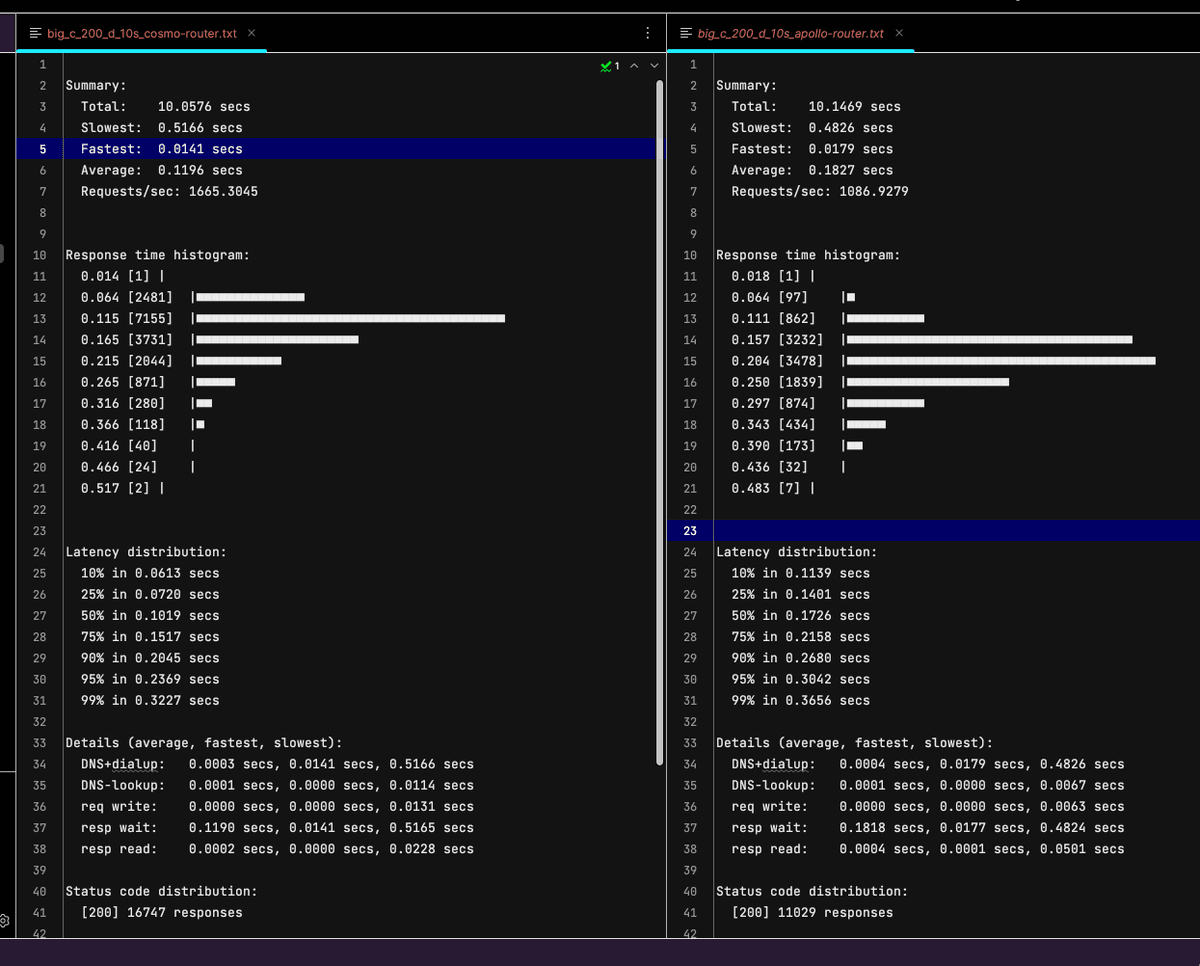- Published on
The Cosmo Router: Next-Gen GraphQL Federatad Router
- Authors

- Name
- Andrew Blase
Introduction
In the dynamic world of technology, GraphQL has emerged as a revolutionary data query language, providing a more efficient and powerful alternative to the traditional REST API. But what exactly is GraphQL, and why has it become a buzzword in the tech industry? In simple terms, GraphQL allows you to ask for exactly what you need and nothing more, making data fetching more precise and streamlined.
Additionally one can link together multipel GraphQL APIs into one supergraph, this is called federations. A supergraph would a touter to control how data is routed between APIs. Routers are pivotal element in the GraphQL ecosystem.
This brings us to the star of today's discussion, the Cosmo Router, a new entrant that promises speed, efficiency, and open-source capabilities. Let's embark on this journey to understand the Cosmo Router, its features, and how it compares against the Apollo Router.

Understanding the Basics
What is a Router in GraphQL?
In the simplest terms, a router in GraphQL acts as a manager that directs queries to the appropriate places, ensuring a smooth and efficient data retrieval process. It is like a traffic cop, directing data traffic to ensure that the right data reaches you quickly and accurately.
Apollo Router vs. Cosmo Router
When we talk about GraphQL routers, the Apollo Router has been a popular choice. However, the Cosmo Router comes with its own set of unique features, promising to be faster and more efficient. In the subsequent sections, we will delve deeper into the functionalities of the Cosmo Router, helping you understand why it could be the better choice for your business.
Diving into Cosmo Router
Architecture Overview
Before we dive into the features, let's understand the architecture of the Cosmo Router. It comprises three main components:
- Control Plane: Think of this as the brain of the operation, overseeing and managing the various functions.
- Registry: This is where all the data schemas are stored, acting as a reference point for data queries.
- Router: The executor that carries out the data fetching based on the instructions from the control plane.

Self-Hostability
One of the standout features of the Cosmo Router is its self-hostability. This means that businesses have the flexibility to host the router on their own servers, giving them greater control over their data and operations. Businesses can use Kubernetes or Docker to deploy. Read more here.
Integration with Existing Systems
In enterprise environments, where there is a need to integrate various APIs, the Cosmo Router comes as a boon, especially with its prowess in handling federated graphs. It facilitates seamless integration, making the management of GraphQL services a breeze.
Features and Functionalities
Label Matcher and Federated Graphs
The Cosmo Router introduces the concept of label matcher, a feature that allows for efficient management of federated graphs. In simple terms, federated graphs are a collection of several APIs brought together to function as a unified whole, enhancing the efficiency and capabilities of GraphQL services.
Error Fixing with OpenAI
A standout feature of the Cosmo Router is its integration with OpenAI to assist in error fixing. This not only simplifies the error-fixing process but also brings in a level of automation, reducing the manual effort involved.
Security and Access Control
In the digital age, security is paramount. The Cosmo Router ensures robust security features, including integration with identity providers like Keycloak, ensuring secure and controlled access to the super graph.
Benchmark Analysis
Cosmo Router Performance
When it comes to performance, the Cosmo Router steals the show with benchmark results showcasing a speed that is about 10X faster than the Apollo Router.

Getting Started with Cosmo Router
Ready to explore the world of Cosmo Router? The official documentation is your go-to resource, offering a comprehensive guide to help you get started.
Glossary
As we wrap up, let's demystify some of the technical terms used in this blog:
- GraphQL: A data query language that allows for more precise data fetching.
- Router: A manager in the GraphQL ecosystem directing queries to the appropriate places.
- Federated Graphs: A collection of several APIs functioning as a unified whole.
- Control Plane: The overseeing component in the Cosmo Router architecture.
- Registry: The component where data schemas are stored in the Cosmo Router architecture.
Conclusion
As we come to the end of this exploration, it is evident that the Cosmo Router stands as a promising contender in the GraphQL space, offering speed, efficiency, and a range of features that make it a worthy choice for businesses, especially those managing GraphQL services at a large scale.
With a deeper understanding of its functionalities and benefits, we encourage you to take a step further. Explore the Cosmo Router documentation and embark on a journey towards more efficient and streamlined GraphQL services.